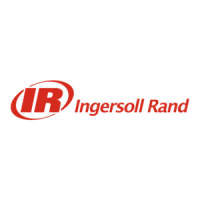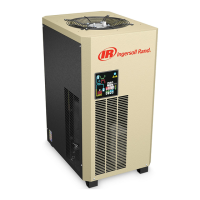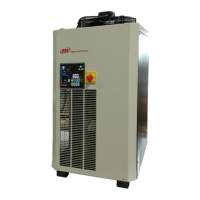
Do you have a question about the Ingersoll-Rand DXR Series and is the answer not in the manual?
| Brand | Ingersoll-Rand |
|---|---|
| Model | DXR Series |
| Category | Dehumidifier |
| Language | English |
Explains signal words (DANGER, WARNING, CAUTION) for hazard levels.
Information about safety labels on the dryer and how to obtain replacements.
Importance of dryer data plates and labels for safety and identification.
Specifies ideal indoor ambient air temperature range (40°F-100°F) for dryer operation.
Guidance on mounting the dryer on a level base and ensuring adequate clearance for airflow and service.
Advice on dryer placement relative to other system components like separators and receiver tanks.
Requirements for user-supplied piping, pressure ratings, and support.
Instructions for connecting and routing condensate drain lines to a disposal system.
Compliance with NEMA standards, local codes, and ensuring correct line voltage.
Information for water-cooled models, including water supply requirements and regulating valve.
Explains how air passes through the heat exchanger and dryer to remove moisture.
Describes the refrigeration system components and their function in cooling the air.
Specifies requirements for cooling air intake for air-cooled dryer models.
Details the ON-OFF switch and the indicator light for power status.
Overview of the monitor, its display, indicators, and controls for dryer status.
Explains the meaning of the four indicator lights: Normal Operation, Check Operating Conditions, Service Due, System Alarm.
How to use the SCAN/SEEK button to view different system temperatures.
Explains normal ranges and warning/alarm set points for various system temperatures.
Discusses the impact of inlet air temperature on dew point and potential dryer performance issues.
Guides on troubleshooting based on refrigerant suction temperature readings and potential malfunctions.
Notes its use by service personnel for analyzing refrigeration system performance.
Explains how ambient air temperature affects dew point and potential dryer shutdown.
Details how water temperature impacts dryer performance and potential issues.
Explains how to display and interpret intermediate air temperature for performance analysis.
Details the serial port for monitoring temperature and error flags, including message format.
Describes optional contacts for remote signaling of operating conditions or alarms.
Instructions on setting the drain valve open and closed times for efficient condensate discharge.
Step-by-step instructions for safely starting the dryer, including pre-start checks and warm-up.
Procedures for shutting down the dryer, especially for electrical repairs.
Guidance on refrigeration system maintenance by qualified personnel and warranty considerations.
Daily checks for automatic drain valve operation and system monitor readouts.
Checking the prefilter differential pressure gauge and replacing the element.
Inspecting condenser coils and replacing the ambient air filter.
Explains the SERVICE DUE indicator and the procedure for resetting it after maintenance.
Process for returning dryers or components to the manufacturer for service.
Instructions for inspecting and replacing the ambient air filter element for optional units.
Step-by-step guide for disassembling, cleaning, and servicing the automatic drain valve.
Instructions for replacing the prefilter element, especially for cold coalescing options.
Provides guidance for common problems like water downstream or excessive pressure drop.
Troubleshooting steps for non-functioning automatic drain valves.
Addresses issues related to inlet air temperature affecting dew point.
Explains causes of liquid water entering the dryer system.
Discusses problems caused by excessive airflow, including pressure drop.
Troubleshooting compressor shutdowns due to high discharge pressure, internal overload, or winding faults.
Addresses issues indicated by HIGH EVAP light, red dew point indicator, high suction, or low discharge temperatures.
Continues troubleshooting for water downstream, high discharge temp, and excessive pressure drop.
Diagnosing and resolving system icing, low/high intermediate temperatures, and compressor cooling problems.
Steps to take when the automatic drain valve is not discharging condensate or is venting continuously.
Steps to resolve issues where the digital display is blank or unresponsive, or timer malfunctions.
Lists available replacement parts for the dryer.
Provides diagrams and schematics for the dryer systems.
Details for the filter-dryer and expansion valve replacement parts.
Replacement parts and kits for the automatic drain valve (ADV).
Replacement parts for compressors and transformers used in the dryer.
Replacement parts for condensers (air and water-cooled) and fan assemblies.
Replacement parts for pressure switches and ambient air filters.
Replacement parts for the System Operation Monitor and indicator lights.
Lists replacement parts for various dryer components for different models.
Diagram illustrating the refrigerant flow for DXR425 and DXR600 models.
Diagram showing refrigerant flow for water-cooled DXR425W and DXR600W models.
Diagram illustrating the refrigerant flow for DXR800 and DXR1000 models.
Diagram showing refrigerant flow for water-cooled DXR800W and DXR1000W models.
Electrical schematic for DXR425-A through DXR1000-A models.
Electrical schematic for DXR425W through DXR1000W models.












